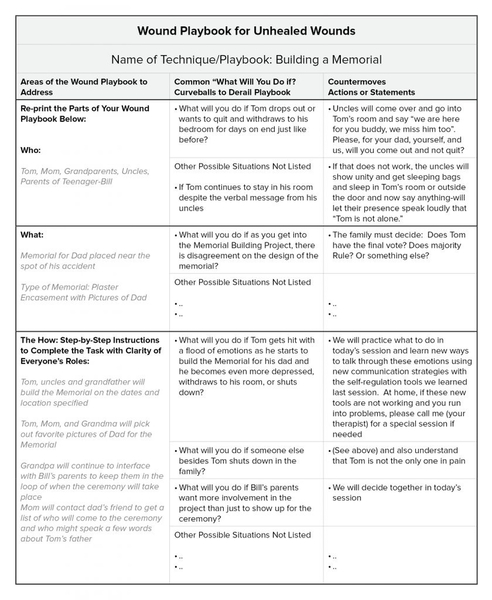Relapse occurs when our clients initially get worse before they get better. It is like stretching a rubber band that will snap back as soon as we let go. Over time, a child’s problem symptoms (i.e., self-harm, aggression, anxiety, extreme disrespect, etc.) that are caused by a traumatic event often become the new normal in a family. This means that family members begin to accommodate their lifestyle around the child’s problems. For example, parents stop setting consistent limits for fear that it will create more anxiety or siblings grow resentful as their emotional needs are ignored.
Therefore, when the family trauma therapist realigns the family it is scary, stressful, and leads to initial resistance within the tension point of “I want to change, but I don’t want to change”. In turn, this tension can lead to relapse until both the traumatized child and their family can hang on long enough to settle into a new lifestyle without the drama of the trauma. If the therapist fails to prepare the family for relapse, family members are caught off guard and are likely to end treatment prematurely.
For more information on this troubleshooting technique, join the Family Trauma Institute’s upcoming webinar on September 25, 2018.
How to Prevent Relapse
There are no shortcuts in the family systems trauma treatment process. The healing process cannot be rushed. Our experience at the Family Trauma Institute indicates that it takes a minimum of 30 days of consistent application of the new Trauma Playbook(s) before permanent change in the child’s problems is possible. During this 30-day transition period, the risk for relapse is high for both the child and family.
The Troubleshooting Technique
To counter this risk, the FST | Family Systems Trauma Model uses the technique of a “troubleshooting checklist” to handle relapses if they occur. Table 1 illustrates what a typical troubleshooting checklist looks like using the Trauma Playbook.
As illustrated in the case example, the trauma playbook is called “Building a Memorial” to help Tom (the traumatized child) and his entire family heal the trauma of unresolved grief due to the sudden and unexpected death of Tom’s father by a drunk driver. The Family Systems Trauma (FST)-trained therapist offers suggestions (within the countermoves column) that will either lead into role plays ("We will practice today how to talk to your son Tom if he is overcome with grief") or problem-solving ("If a family member forgets to show up on Saturday or Sunday, just remind them for next week"). As part of the troubleshooting technique, the FST therapist will actively suggest countermoves by writing them on this template immediately prior to the session. Without these jump start suggestions, the family is often lost on how to start or what to do. Or, the session can easily digress into an unproductive brainstorming session. Within the session itself, these suggestions can always be rejected, altered, or modified by the family. However, the benefit is that it provides both therapist and family quick footing for next steps.
An Important Note
Using the troubleshooting technique, relapse is communicated to the traumatized family as a normal part of the healing process. And because of this fact, one must proactively prepare for it. Unfortunately, we find that troubleshooting is the most unused technique in mental health treatment by therapists. If troubleshooting is used at all, it is done after a relapse has already occurred rather than proactively implemented beforehand. Or troubleshooting is verbal and rarely typed up in a systematic step-by-step table format with practice role plays as needed. As a result, the traumatized child and family are left unprepared and without any concrete tools to counter relapse or “what will you do if...” curveballs to derail the trauma playbook.
This problem is further exacerbated because a traumatized family is often burnt out and brittle before treatment even begins. The family does not have the time or energy to bounce back or reboot quickly after a relapse. As a result, the family will often end treatment prematurely out of frustration or falsely believe that the trauma treatment is not working. This is why the Family Trauma Institute devoted three entire chapters (Chapters 11, 12, and 13) on troubleshooting and relapse prevention in Treating the Traumatized Child: A Step-by-Step Family Systems Approach. It is critical that trauma therapists master the troubleshooting technique to prepare the family for relapse before it happens, not after.
Final Thoughts
Trauma treatment is difficult even on our best day. But without troubleshooting, we risk setting up our traumatized families for failure. Relapse is normal. We can use this troubleshooting checklist technique as a clear and visual roadmap to empower our families with the problem-solving tools they need to weather the storm. We can then turn to our families with confidence that they have the tools they need to hold on for the next 30 days and beyond if needed to bring about permanent healing. In turn, the traumatized child is greatly relieved. Through the troubleshooting checklist, everyone’s roles in the family are clear and everyone has a stake in the healing process. It is not on the child’s shoulders alone to change, but an entire village.
Scott P. Sells, Ph.D., MSW, LCSW, LMFT, is the author of three books, Treating the Tough Adolescent: A Family-Based, Step-by-Step Guide (1998), Parenting Your Out-of-Control Teenager: 7 Steps to Reestablish Authority and Reclaim Love (2001), and Treating the Traumatized Child: A Step-by-Step Family Systems Approach (2017). He can be contacted at spsells@familytrauma.com or through LinkedIn.
For more information on this troubleshooting technique, join the Family Trauma Institute’s upcoming webinar on September 25, 2018.





Comments (3)